 History
History  History
History  Weird Stuff
Weird Stuff 10 Fascinating Things You Might Not Know About Spiders
 Food
Food 10 Everyday Foods You Didn’t Know Were Invented by the U.S. Military
 History
History 10 Odd Things Colonial Americans Kept at Home
 Weird Stuff
Weird Stuff 10 Superstitious Beliefs That Once Consumed Entire Cultures
 History
History 10 Bizarre Friendly Fire Incidents in Military History
 Technology
Technology 10 Modern Technologies That Accidentally Imitate Ancient Magic
 Mysteries
Mysteries 10 Mysteries of the Human Genome
 Weird Stuff
Weird Stuff 10 Things So Rare They’ve Only Been Found Once
 History
History 10 Legends Whose Last Moments Undid Their Glory
 History
History 10 Great Escapes That Ended Right Back in Captivity
 Weird Stuff
Weird Stuff 10 Fascinating Things You Might Not Know About Spiders
 Food
Food 10 Everyday Foods You Didn’t Know Were Invented by the U.S. Military
Who's Behind Listverse?

Jamie Frater
Head Editor
Jamie founded Listverse due to an insatiable desire to share fascinating, obscure, and bizarre facts. He has been a guest speaker on numerous national radio and television stations and is a five time published author.
More About Us History
History 10 Odd Things Colonial Americans Kept at Home
 Weird Stuff
Weird Stuff 10 Superstitious Beliefs That Once Consumed Entire Cultures
 History
History 10 Bizarre Friendly Fire Incidents in Military History
 Technology
Technology 10 Modern Technologies That Accidentally Imitate Ancient Magic
 Mysteries
Mysteries 10 Mysteries of the Human Genome
 Weird Stuff
Weird Stuff 10 Things So Rare They’ve Only Been Found Once
 History
History 10 Legends Whose Last Moments Undid Their Glory
10 Amazing Ways That Animals Are Smarter Than You May Realise
Everyone knows the stories of crows that place rocks into glasses to get access to the water within, but did you know there are many other animals which are more intelligent than you may realise. Scientists have long found the research of animal intelligence to be a challenging task, as comparing animals to humans (or even animals to other animals!) means you may miss out on some clever techniques they have used to survive in their surroundings. The way animals have learned to adapt to their surroundings is nothing short of incredible, and it may surprise you how smart their solutions to problems actually are.
Top 10 Horrific Ways Animals Were Used For Entertainment
10 Chimpanzees with better memory than humans?
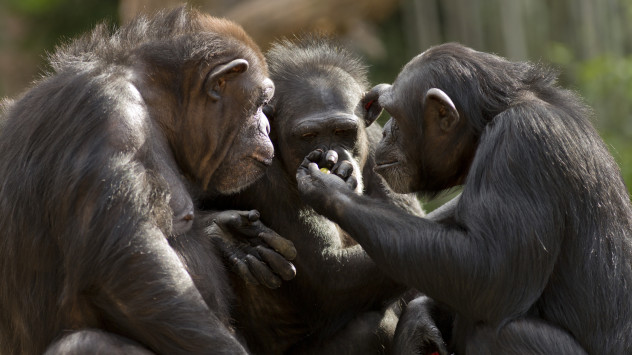
The intelligence of chimpanzees is relatively well known, and as such they are common target for study by scientists. One way a chimp’s memory has been studied is through hiding food under colored boxes in front of them. The chimps then had to point at a box, and if it contained food, they received it. After this, the memory part comes in, and the boxes are hidden for 15 seconds, after which they can make another choice. On average, chimpanzees were able to remember 4 items, with the best remembering up to 7. Now this does not sound too impressive, but it turns out it is very similar to how humans do on similar tasks!
But a chimp’s memory does not stop there. ‘Ayumu’ the chimp surpasses humans on some cognitive tasks! A series of numbers are shown on a screen, and then after a short amount of time (just one fifth of a second) they are hidden by white boxes. Humans performing this task often fail to remember all the numbers, but Ayumu has no trouble with it, being able to successfully memorize sequences of 9 numbers. Not to worry though, we are still a way off ‘Planet of the Apes’!
9 Elephants understand the power of teamwork
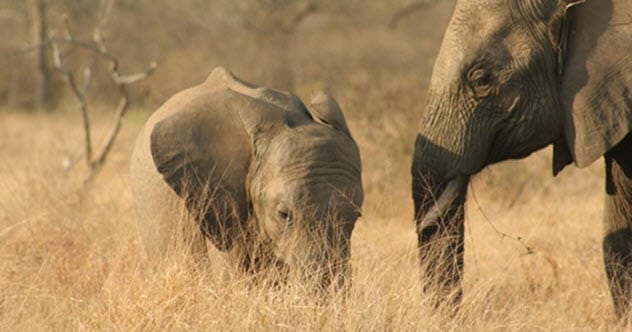
The fact elephants are smart is no surprise. Their brain is three times larger than a humans, which means they have three times the number of brain cells too! In fact, elephant intelligence is well-studied, with evidence that they can learn by mimicking, compassion, and even caring for other elephants less fortunate than themselves. These are all traits not often seen within the animal kingdom, as many animals look after only themselves.
What is most interesting about elephants’ is that they can cooperate to achieve a goal. Scientists tested this by putting food in a box, and the only way for the elephants to get the food out is for two elephants to simultaneously pull on two separate ropes. Elephants were able to do this and even more impressively, after the elephants had learnt they needed to work together to achieve their goal, they didn’t try pulling the ropes unless another elephant is nearby. So, if you ever need a helping trunk, just find a nearby elephant!
8 Parrots can do more than speak

Everybody knows that parrots can reproduce human language, but what is less well known is that some are believed to be able to understand what they are saying also. The best example of this is Alex the Parrot, an exceedingly smart parrot whose name was an acronym for ‘Avian Language Experiment’. Alex was so smart that he was able to correctly answer questions made for human six-year old’s, and because of this has been called the “Einstein of parrots”.
Alex was able to identify both colors and shapes, and answer questions about objects presented to him. He knew how to identify a variety of objects by name, as well as compare them using terms such as ‘bigger’ and ‘smaller’. When the researchers worked with the other parrots in the lab, Alex would often answer for them, and tell the other parrots to ‘Say Better’. Even crazier, the researchers believed that he had the emotional level of a two-year-old. Unfortunately, Alex died unexpectedly at the age of 31, with the researchers stating that they do not believe Alex had reached his potential yet.
7 Dolphins can mimic human actions
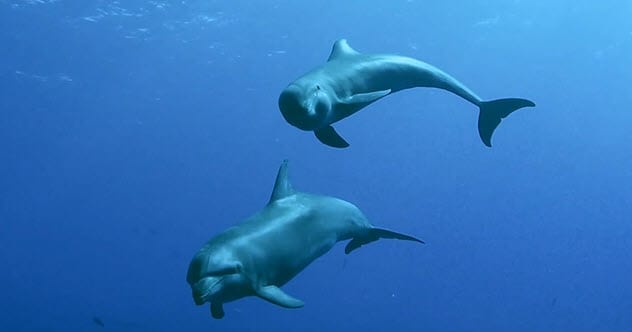
That title probably sounds a bit strange; you may be wondering how an animal without arms and legs is able to mimic us, and that simple fact is what makes it impressive. You may have been to a zoo and have seen chimps mimicking you or those around you, but they have the ‘correct’ limbs to be able to do this.
It turns out dolphins can do this too, using their flippers and tail to attempt to mimic what humans are doing. If a human were to float on their back in the water, the dolphin can copy them, if they cross their arms, the dolphin can mimic that also with their flippers. What is even more impressive is a dolphin’s other senses are so advanced, they can even mimic human actions if they are ‘blindfolded’, which for dolphins means having ‘eyecups’ placed over their eyes.
6 Some birds can plan for the future
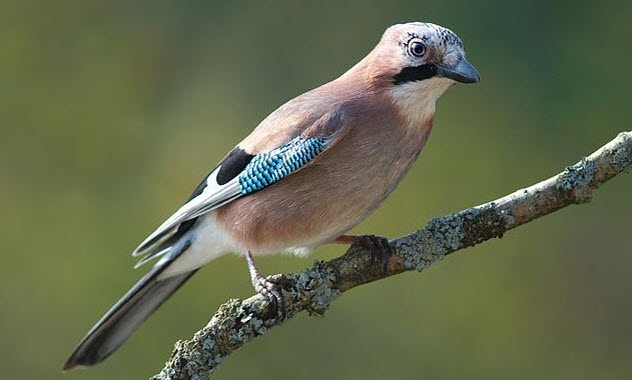
The ability to plan for the future is something that sets humans apart from many animals, we are able to effectively choose long-term rewards over short-term rewards, meaning we choose actions that benefit us more in the future than ones that benefit us less now. A certain species of bird, the western scrub jay, is able to do this as well.
Scientists tested this by allowing these birds to access and eat food, and then give them a period of time to allow the birds to store some food for the future. The birds could eat first so that their current emotional state (hunger) would not impact their decision to store food. The birds chose to store food for the next morning, showing they do not just think about the here and now, but also are able to make decisions that benefit them in the future.
5 Pigs can use mirrors

Mirror use is often used as an assessment of whether an animal is able to identify themselves in a mirror, and surprisingly few animals are actually able to do it. If you have a pet, try placing them in front of a mirror and see how they react, some may even get angry another animal is in their house! Pigs on the other hand, are able to use them for slightly more complex tasks.
Pigs were left with a mirror in their enclosure for around 5 hours, so they could get used to it and how it works, and after this period a food bowl was placed in a spot that the pig could only see through the mirror. Almost all the pigs tested were able to find the food quickly. This is impressive, as it means they were able to not only identify the food in the mirror, but also use the mirror to identify features within their environment and understand that it is a reflection of the real world. Pigs are one of the smartest animals, learning to distinguish random scribbles from those they have seen before, and also move a cursor on a screen using their snout, so perhaps it should be no surprise they are able to use mirrors so effectively.
4 Bonobos can learn to communicate

Just like chimps, Bonobos are also able to perform activities beyond what would be expected of them. What makes bonobos particularly interesting is the wide variety of skills some of them have been able to learn. One specific Bonobo worth mentioning is called Kanzi, who was able to learn sign language and symbols to communicate. Even more impressive, Kanzi was able to learn some of his sign language just from watching a video of another intelligent animal, Koko the Gorilla. With the symbols, he can communicate with researchers just based on the symbols that he has learnt.
Kanzi can not only communicate however, but he has also learnt how to sharpen rocks to cut ropes to access food. Kanzi, as well as some other Bonobos, have also managed to learn to ‘cook’ using an oven, without being shown or instructed by researchers. This adds some credence to the idea that animals can not only learn to cook, but also delay their eating to improve its quality. It also suggests advanced tool use beyond use of sticks and rocks may also be possible in animals.
3 Cows are natural learners
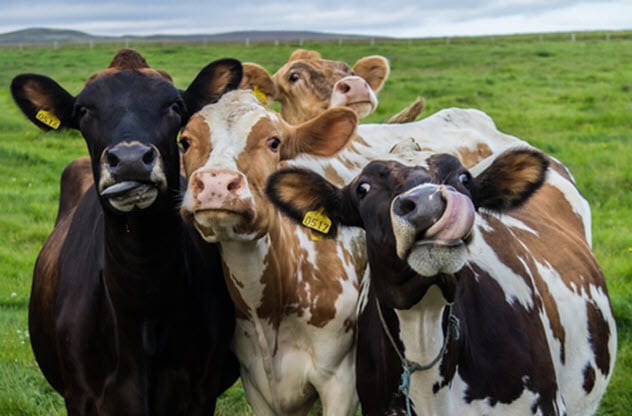
It may come as a surprise to see a second farm animal on this list, especially cows, an animal not known for their intelligence. When you see cows in fields it looks as if they are just mindlessly wandering around and eating grass, and for the most part that is what they are doing. But what may come as a surprise is that cows have social circles, and avoid cows that have not treated them nicely, and become friends with ones that have. An interesting finding as it shows cows may actually understand more about social circles than some humans!
Another fascinating finding about cows is that when researchers reward cows with a treat for doing well on a task that they were improving on they had increased heart rate and were more vigorous in their movements than when they were just given a reward for no reason. This implies that, similar to humans, cows prefer being rewarded for what they have done, rather than just randomly.
2 Octopus Mimicry
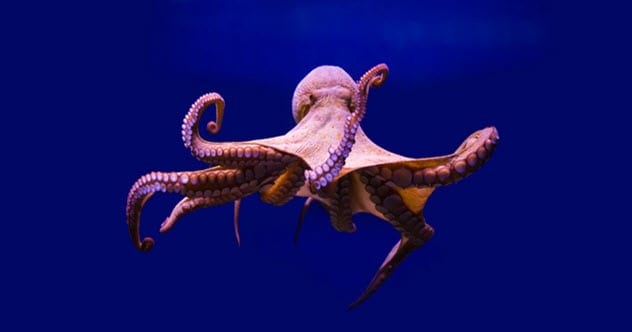
Octopuses are a bit different to all other creatures on this list, mainly due to them not being mammals, but invertebrates, but do not let that affect your view on them. In fact, octopuses are by far the worlds smartest invertebrates, using their strangely shaped body to solve problems in unique ways. For example, an octopus can grip onto a jar and use its extremely flexible arms to open it so that it can eat the contents. This may not seem like it requires much intelligence, but an important point to remember is that jars are designed to be opened by hands with thumbs, something octopuses lack.
This is not the limit to their intelligence however, as mimic octopuses are able to successfully copy other animals to scare off other predators. This means that if they see a creature, they can adapt its body to match that other creature. This is a skill that requires both knowledge of their own body, but also the ability to learn what other creatures look like.
1 Rat Mazes
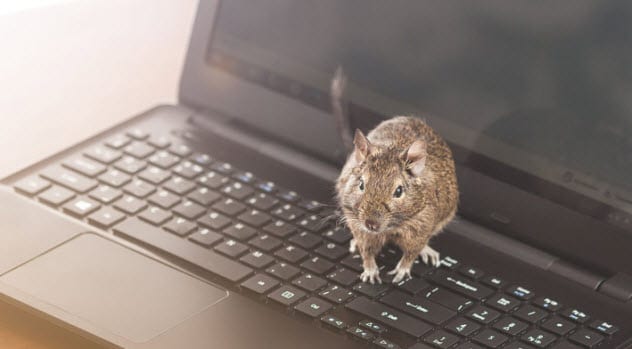
Everyone knows about rats in mazes, the classic experiment where you put some cheese at one end and the rat at the other and see if they can solve this, but did you know this shows quite a high level of intelligence? To do this, rats must process a large number of sensory cues and analyze their surroundings to make their way out of complex spaces. Even more amazing, like elephants, rats show altruism, helping other members of their species. So next time you see one, just remember it may be on its way to help a friend!
Top 10 Magical Powers Attributed To Animals








